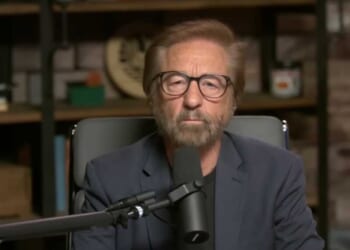This column was excerpted from Greenhut’s forthcoming booklet, “Protecting Cities from Wildfires: Improving California’s Land-Use, Water and Brush-Clearance Strategies.” Complimentary, downloadable copies will be available next week at the Free Cities Center website.
News reports cite the beginning of the 2025 Los Angeles fires on January 7 at 10:30 am, as the Santa Ana winds blew a cloud of black smoke over heavily populated areas in and around Los Angeles. An hour or so later, NBC 4 Los Angeles reported that “gridlock formed on Sunset Boulevard,” which “blocked people in traffic for miles as they desperately tried to evacuate and get away from the dangerous flames. The Palisades Fire quickly expanded, consuming homes, cars, and anything in its path.” The Eaton Fire in the San Gabriel Mountains began that evening.
The nightmarish situation grew worse rather quickly. The two fires (and five smaller ones) ultimately consumed more than 37,000 acres. When it was all over, 24 days later, the fires claimed 30 lives and more than 16,000 homes and other structures, and caused the evacuations of 180,000 people. Insurance companies expect losses of more than $30 billion, with total economic damage pegged at more than $250 billion. They were not only among the most destructive wildfires ever in California, but among the costliest natural disasters in U.S. history. (RELATED: After the Wildfires, a Predictable Bailout)
Unfortunately, state officials have embraced policies — an attempted ban on internal-combustion vehicles, a cap-and-trade system designed to reduce industrial carbon emissions, etc. — that are designed to change the trajectory of the Earth’s climate rather than manage its wildfire seasons. It’s always seemed bizarre that a state government that can’t even, say, manage its own budget and infrastructure effectively thinks that it can somehow make a dent in a problem of such scientific complexity and that involves 195 international governments. (RELATED: When Gavin Met Donnie: Debate Continues Over Disastrous California Wildfire)
Instead of taking this overly ambitious approach, it seems wiser for the state government to embrace policies that improve our resilience to changing weather patterns. A 2022 University of Chicago study found that a “single year of wildfire emissions is close to double emissions reductions achieved over 16 years.” Perhaps a more attainable agenda is in order:
Battling governmental incompetence: This is perhaps the toughest reform area, as there is no easy button to improve governance. The voters make their choice — and it’s not always easy to increase oversight and accountability, especially in cities with little partisan competition. However, the depth of public anger following the Los Angeles wildfires could jump-start political debates in the city, which is always a healthy outcome. However, California cities are long overdue for debating the nature of their union-dominated employment systems. Lost in the fight between Mayor Karen Bass and former Fire Chief Kristin Crowley was the degree to which union priorities drive spending policies. Cities such as Los Angeles need to reform their pension systems, their overtime rules, and other employee compensation issues. By achieving cost savings in these areas, they can have more money to earmark for additional firefighting — and even hire more firefighters.(RELATED: Demonizing Heroic Private Firefighters)
Improving brush clearance: California’s brush-clearance efforts are inadequate and mired in layers of state and local bureaucracy. For starters, the state needs to step up its funding for these efforts — and not just pay lip service to their importance. This doesn’t require new expenditures, but merely prioritizing them among the long list of spending programs included in California’s $325-billion budget. The state could, for instance, shift funding from electric vehicle mandates to forest thinning and relax utilities’ renewable energy mandates to encourage them to harden power poles. The state could also provide tax cuts to homeowners to help them upgrade to fire-resistant materials. The state should reduce its timber-harvesting rules to encourage private brush clearance, among other simple policies.
Better water policy: Basically, California needs to get serious about increasing its capacity to store water — and not rely solely on conservation, which provides only diminishing returns, and on managing scarcity. The state should permit privately funded desalination plants, complete Sites Reservoir (a long-planned off-stream storage facility north of Sacramento), expand its water-recycling program modeled on Orange County’s nation-leading efforts, loosen regulations that restrict water trading, and store more water during rainy years so we have it during droughts. Completing the Delta tunnel(s) project could reduce delays in sending water from Tracy to farms and cities southward. California needs to prioritize abundance and further reform the California Environmental Quality Act (CEQA), so no-growth activists can’t delay or stop every proposed water project. Water is admittedly tangential to wildfires, but more water will help reduce drought and boost firefighting capabilities.
Enacting insurance reforms: California has belatedly enacted many of the insurance reforms that are needed to improve property insurance availability. It has sped up the rate-review process, allowed insurers to factor rising reinsurance rates into their premium pricing, and allowed insurers to use catastrophe modeling to set prices. The Department of Insurance has approved almost every recent rate hike that’s come before it — a necessary albeit painful approach to keep insurers from fleeing and further overburdening the state-created insurer of last resort, the FAIR Plan. But, ultimately, the state needs to revisit Proposition 103, the 1988 ballot initiative that imposed a prior-approval rate system that amounts to a system of price controls. Until the state’s voters reform this at the ballot box, California’s insurance market will not function effectively or efficiently. And shortages will remain.
Rethinking land-use regulations: While I applaud Gov. Gavin Newsom’s decision to exempt Los Angeles fire victims from the Coastal Act and CEQA and his recent efforts to push through broader CEQA exemptions as part of the budget process, I’m frustrated that the state Legislature never undertakes permanent reform of the latter (the former would need to go to the ballot box). CEQA continues to impede every type of construction. Five years after a fire that demolished the town, Paradise — which never received such useful exemptions — has not been fully rebuilt. Even with the LA exemptions, the rebuilding process is slow, with only 30 permits so far approved in the two main wildfire areas as of June 2025 per the state’s permitting-progress dashboard. This speaks to the large amount of bureaucracy in the city and county. Local officials need to find ways to streamline these building approvals.
Prioritizing privatization: California’s state and local officials continue to choose government approaches as their first-reach answer to everything. They often dismiss — or even actively oppose, in the case of private firefighters — efforts that unleash the most energetic part of our economy, the private sector. This “reform” requires more of a change in perspective than any particular policy. But the state could encourage the creation of homeowners’ associations, such as the one described at the Tahoe Donner Association. Despite being in the midst of a fire-prone forest, that community has resisted devastating fires by implementing a variety of private restrictions and building requirements. I’d urge California lawmakers to look at these private-sector approaches and find ways to promote them in other communities statewide.
California has done some of the right things after the latest wildfires, but it’s taken an unprecedented disaster to prod state officials into taking even modest, productive steps forward. Let’s hope the Los Angeles tragedy will indeed serve as a wake-up call and that state lawmakers don’t just go back to business as usual after it fades from the public’s memory.
Steven Greenhut is Western region director for the R Street Institute, director of the Pacific Research Institute’s Free Cities Center, and a member of the Southern California News Group editorial board. Write to him at [email protected].
READ MORE from Steven Greenhut:





![Gavin Newsom Threatens to 'Punch These Sons of B*thces in the Mouth' [WATCH]](https://www.right2024.com/wp-content/uploads/2025/08/Gavin-Newsom-Threatens-to-Punch-These-Sons-of-Bthces-in-350x250.jpg)
![ICE Arrests Illegal Alien Influencer During Her Livestream in Los Angeles: ‘You Bet We Did’ [WATCH]](https://www.right2024.com/wp-content/uploads/2025/08/ICE-Arrests-Illegal-Alien-Influencer-During-Her-Livestream-in-Los-350x250.jpg)








